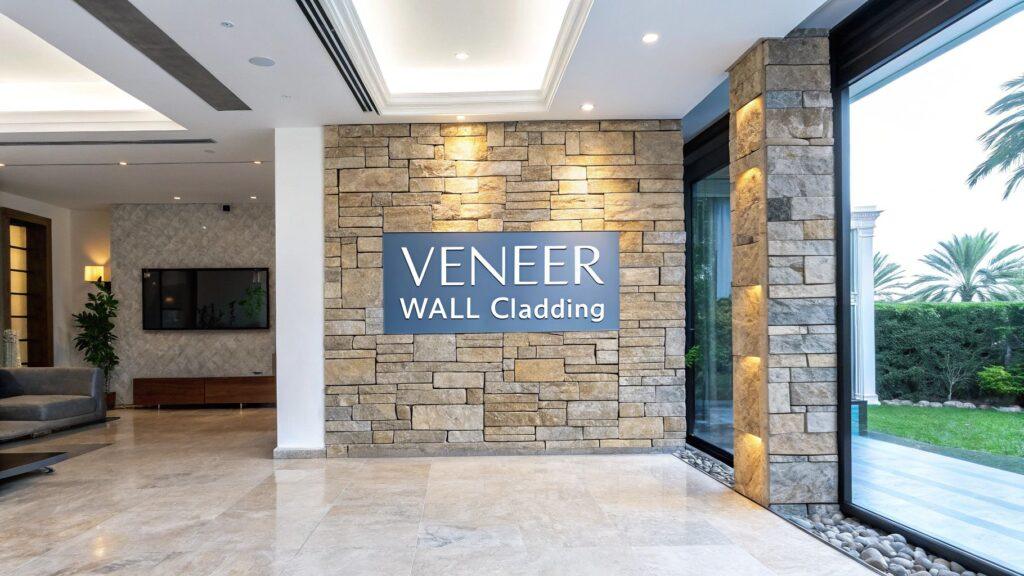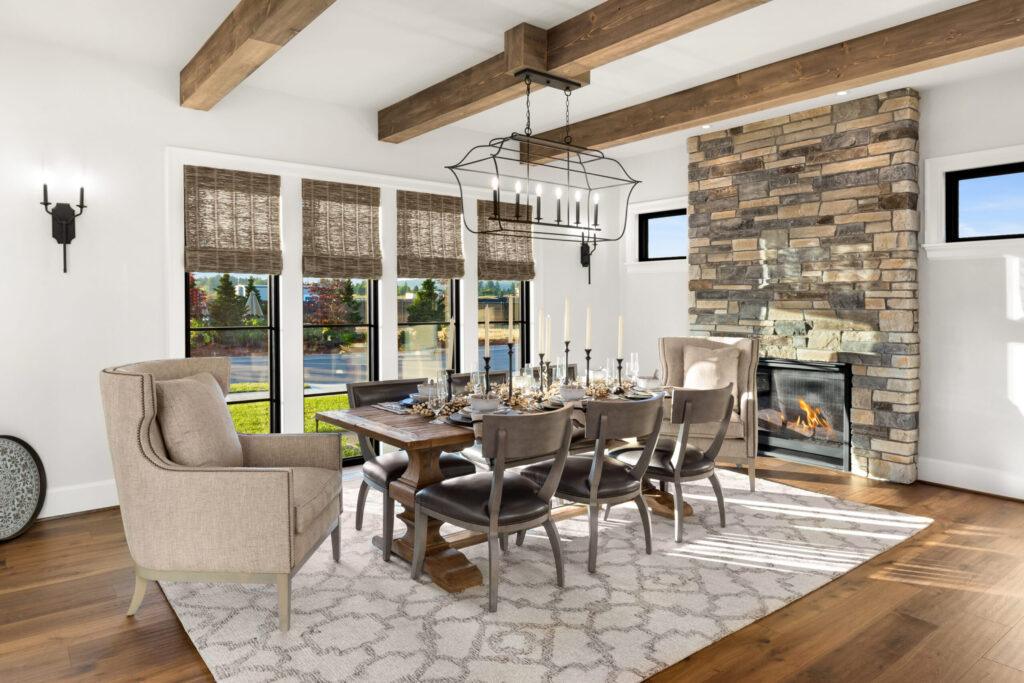Think of veneer wall cladding as a way to give your walls a sophisticated new 'skin'. It’s a decorative technique where a thin layer of a high-end material, like real stone, is bonded to an existing wall. This clever method gives you the authentic look and feel of a solid material, but in a much more lightweight and cost-effective package, all without needing a major structural overhaul.
Understanding the Essence of Veneer Wall Cladding
Let's say you're dreaming of a gorgeous, rugged stone wall for your living room. The traditional route—building it from solid stone blocks—is a massive undertaking. It's incredibly heavy, eye-wateringly expensive, and puts immense strain on your home's structure.
Veneer wall cladding is the brilliant workaround. You get the exact same authentic look and texture by applying thin, precisely cut sheets of real stone directly onto your existing drywall or structural surface. It's that simple.
This approach completely opens up your design possibilities. You're not just covering a wall; you're layering in character, texture, and a sense of depth. The fundamental idea is to separate the beautiful finish from the load-bearing part of the wall, which gives architects and designers incredible creative freedom.
More Than Just a Pretty Face
While the visual transformation is what first grabs your attention, veneer wall cladding is doing more than just looking good. It also acts as a protective shield for the wall underneath, guarding it against moisture, everyday knocks, and the elements. This extra layer can really boost the longevity of your walls, whether they're inside your home or on an exterior facade.
The popularity of this technique has grown hand-in-hand with the demand for natural textures in modern design. You can see this reflected in the booming construction sector. In Turkey, for example, the construction market is projected to reach TRY 1.48 trillion by 2025. This growth naturally fuels the need for innovative finishing materials like veneer cladding, which are becoming a staple in residential, commercial, and public projects aiming for that high-end aesthetic. You can find a deeper dive into these trends by exploring the Turkish construction market outlook.
Key Advantages at a Glance
So, what makes veneer wall cladding such a go-to solution for both new builds and renovations? It's all about blending elegance with pure practicality.
Veneer wall cladding is the art of achieving a luxury finish without the weight and cost of solid materials. It makes the beauty of natural stone and wood accessible for a much wider range of architectural projects.
To make it even clearer, the table below breaks down the core benefits that have made this technique a favourite in modern construction and interior design.
Core Advantages of Veneer Wall Cladding
This table summarises why veneer wall cladding is a leading choice for residential and commercial projects.
| Benefit Category | Description |
|---|---|
| Aesthetic Versatility | Offers the authentic look of premium materials like stone, wood, or brick, adaptable to any design style from modern to rustic. |
| Lightweight Nature | Significantly reduces the structural load on the building, making it suitable for a wider range of applications, including retrofitting. |
| Cost-Effectiveness | Provides a high-end look for a fraction of the material and labour cost associated with installing solid stone or wood walls. |
| Protective Function | Acts as a durable outer layer that shields the underlying wall from moisture, wear, and environmental damage, extending its lifespan. |
These advantages work together to offer a powerful combination of style, performance, and value that's hard to beat.
Exploring Different Types of Wall Veneer
Choosing the right material for your veneer wall cladding is a lot like an artist selecting their paints; it’s a decision that fundamentally defines the mood and character of the finished space. The world of veneers is incredibly diverse, offering a whole spectrum of textures, colours, and performance features. Getting to know these differences is the first step towards finding the perfect match for your project’s aesthetic vision and practical needs.
Your final choice will likely come down to a few key factors: the look you're going for, where it will be used (indoors or out), how much maintenance you're prepared for, and of course, your budget. Every type of veneer brings its own unique personality to the table, from the rugged, timeless appeal of natural stone to the classic warmth of wood.
To give you a better idea of what’s out there, have a look at the image below. It puts some of the most popular veneer options side-by-side.
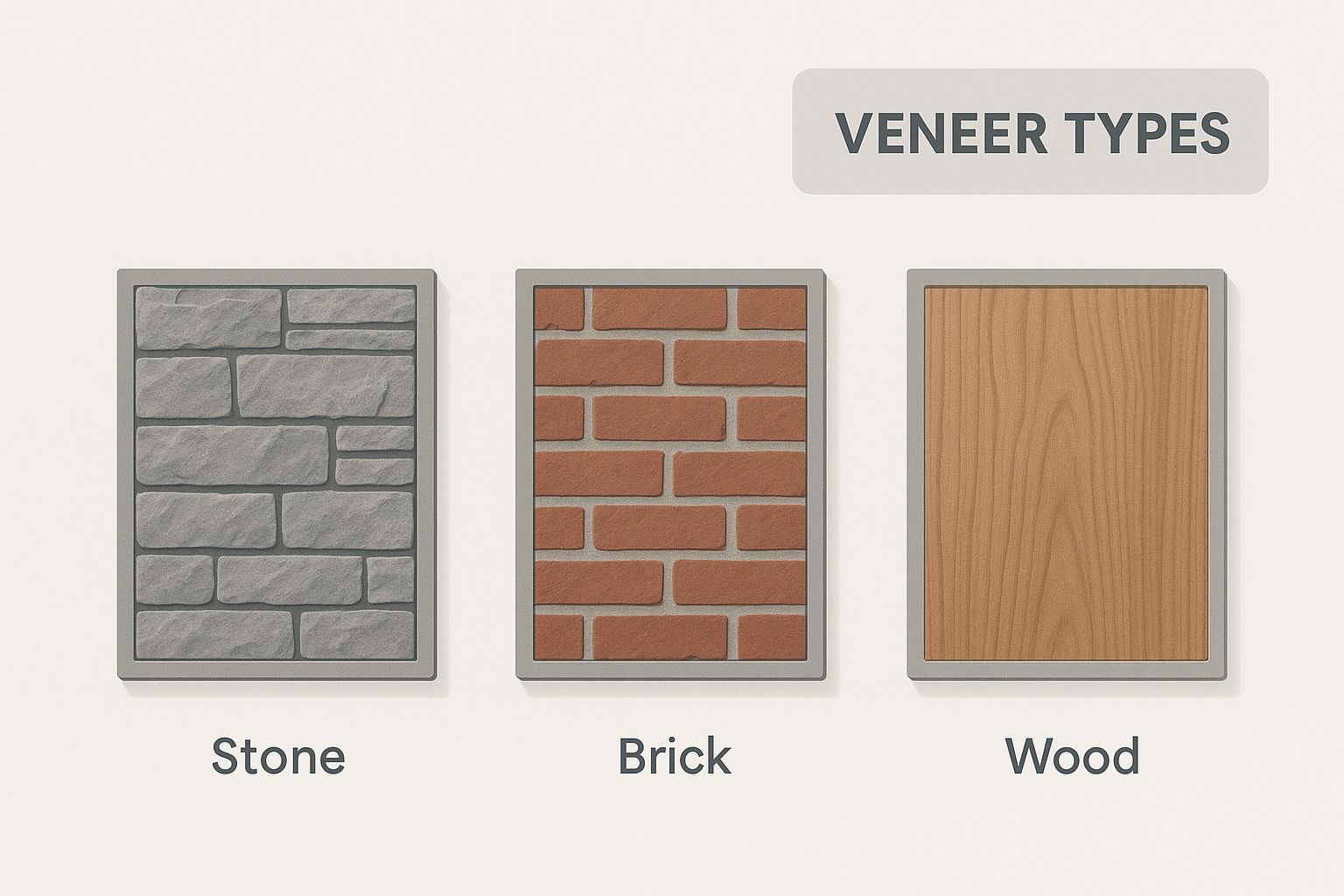
This comparison really shows how different materials like stone, brick, and wood can create completely different architectural feelings, even on the very same wall. Let's dig a little deeper into each of these.
Natural Stone Veneer
Natural stone veneer starts its life as real, quarried stone. It’s then carefully sliced into thin, lightweight panels. This clever process keeps all the authentic texture, unique colour variations, and enduring appeal of materials like slate, quartzite, and travertine, but leaves behind the massive weight and expense of traditional solid stone blocks.
It’s really the top-tier choice for projects where you simply can't compromise on authenticity and longevity. There's nothing that quite captures the organic, grounded feeling of a genuine stone surface. This makes it an amazing choice for creating a striking feature wall, a distinguished building exterior, or a sophisticated fireplace surround.
- Pros: Unmatched in authenticity and visual beauty, exceptionally durable, and naturally resistant to fire and weather.
- Cons: Tends to be more of an investment than manufactured options and may need sealing to protect against stains.
If you’re leaning towards a genuine material, the next logical step is to explore the various types of stone veneer to see the full range of possibilities.
Wood Veneer
Wood veneer is all about bringing a sense of warmth, classic style, and natural sophistication into a room. It's made by slicing incredibly thin layers from real timber, capturing the beautiful grain patterns and rich tones of woods like oak, walnut, or even bamboo.
This is a fantastic option for crafting inviting and peaceful interiors. Just imagine a warm, wood-panelled accent wall in a bedroom or a sleek, modern office space finished with polished wood. It’s a truly versatile material that feels right at home in both traditional and contemporary designs.
Wood veneer is brilliant at adding organic texture and acoustic warmth to interiors. It makes rooms feel more comfortable and visually grounded, completely changing the atmosphere of a space.
It’s worth noting, however, that most wood veneers are designed for indoor use. They can be vulnerable to moisture and fading from UV light unless they’ve been given a specialised protective treatment.
Faux Stone and Brick Veneer
Often called manufactured or cultured stone, faux veneers are cleverly engineered from a blend of concrete, lightweight aggregates, and mineral oxide pigments for colour. They are cast in moulds made from real stone and brick, which allows them to replicate natural textures and colour patterns with surprising accuracy.
The big appeal here is the blend of affordability and consistency. Faux veneers are generally easier on the wallet and much lighter than natural stone, which can simplify the installation and bring down labour costs. Because they are manufactured to a uniform shape and size, they can also speed up the whole application process.
- Pros: More budget-friendly than natural stone, lightweight, easier to install, and comes in consistent colours and styles.
- Cons: Might not have the one-of-a-kind character of real stone and can be less durable over the very, very long term.
Faux veneer is a huge part of a rapidly growing global market. The international decorative veneer industry is projected to climb from $3.52 billion in 2024 to over $5 billion by 2034, and you can see this trend reflected in Turkey’s own expanding construction sector.
The Functional Benefits of Veneer Cladding
While the visual impact of veneer wall cladding is what usually grabs the headlines, its practical advantages are just as impressive. It’s more than just a pretty face; veneer acts as a high-performance skin for your building, bringing real benefits to its durability, comfort, and value. This blend of form and function is precisely what makes it such a smart investment.
Think of veneer cladding as a tough, tailor-made coat for your walls. It creates a solid barrier between your building's structural core and the elements. This protective layer is your first line of defence against everything from driving rain and moisture to the everyday scuffs and bumps in a busy hallway.
By shielding the wall beneath, the veneer helps prevent the underlying materials from degrading. It stops moisture from getting in, which means no mould, and it resists physical damage. This is fundamental to extending the life of the entire wall, keeping the building sound and secure for years to come.
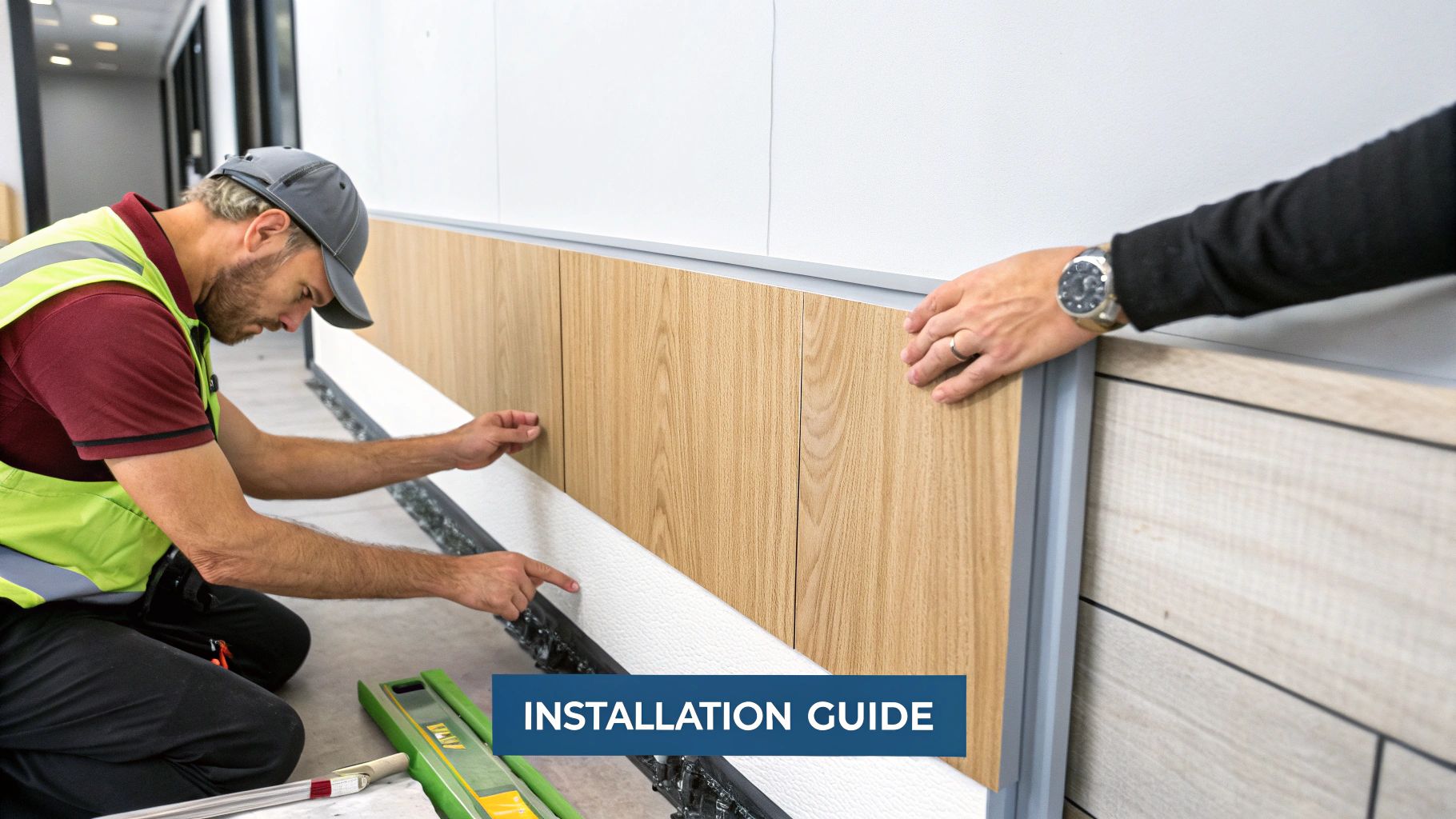
Enhancing Thermal and Acoustic Performance
One of the standout functional benefits of veneer wall cladding is how it boosts a building's energy efficiency. While the veneer itself has some insulating properties, its real power comes from being part of a system. A dedicated layer of insulation can be fitted behind it, creating a seriously effective thermal envelope.
This setup helps regulate the temperature inside by slowing down heat transfer. In winter, it keeps the warmth in, and in summer, it keeps the blistering heat out. The upshot is a more stable, comfortable interior that requires less energy to heat and cool, leading to a welcome drop in your utility bills.
On top of that, many veneer materials are brilliant at controlling sound.
- Stone and Wood: These natural materials are dense with irregular surfaces, a perfect combination for absorbing and scattering sound waves.
- Noise Reduction: Installing a stone or wood veneer can noticeably dampen background noise and cut down on echo inside a room.
- Quieter Spaces: This makes it an excellent choice for creating peaceful environments in homes, offices, restaurants, or anywhere else acoustic comfort matters.
The Advantage of Low-Maintenance Durability
In our busy lives, nobody wants to spend their weekends on building maintenance. Veneer wall cladding, especially when made from natural stone or high-quality bamboo composites, really shines here.
Unlike a painted wall that needs redoing every few years or plaster that can crack and stain, veneers are built for the long haul. They resist fading, are simple to clean, and handle impacts and scrapes with ease.
Natural stone veneer, for instance, is incredibly durable and looks great with just an occasional wash. Likewise, innovative products like thermo-treated bamboo cladding are specifically engineered to resist moisture, rot, and insects. It’s a fit-and-forget solution that holds its own for decades. This low-maintenance quality doesn't just save you time and money; it ensures your property keeps its good looks and value over time, making veneer cladding a genuinely practical and intelligent choice.
Inspiring Design Ideas for Veneer Walls
The real magic of veneer wall cladding is its power to completely transform a space. It’s not just a finish; it's a design tool that lets you set a mood, build a focal point, and tell a story through texture and colour. By looking at how it’s used in different settings, you can see how this versatile material turns an ordinary wall into a genuine work of art—and maybe spark a few ideas for your own project.
Let's walk through some real-world examples. Picture a modern living room where one entire wall is covered in a dramatic, textured slate stone veneer. That single move instantly anchors the room, creating an undeniable focal point that feels both rugged and sophisticated. The natural clefts and colour shifts in the stone bring a depth and character that paint or wallpaper just can't touch.
But it’s not just for big, dramatic statements. Consider the effect in a more intimate space.
Creating Ambiance in Residential Spaces
In a home, veneer cladding is all about cultivating a specific atmosphere. The trick is to match the material to the feeling you want to create in each room.
- The Serene Bedroom: Imagine the wall behind your headboard clad in warm, natural wood veneer panels. The gentle grain and soft tones create a tranquil, calming vibe, turning the room into a peaceful retreat.
- The Rustic Kitchen: A rustic brick veneer can bring a charming, farmhouse feel to a kitchen backsplash or feature wall. It adds a touch of history and cosiness that makes the whole space feel more inviting.
- The Contemporary Bathroom: Sleek, large-format stone veneer in a light colour like travertine or quartzite can turn a bathroom into a spa-like escape. Its clean lines and subtle textures create a sense of understated luxury.
In each case, you can see how a carefully chosen veneer becomes a core part of the room’s identity.
Elevating Commercial and Public Environments
Veneer wall cladding makes just as strong an impression in commercial spaces, where it can be used to reflect a brand's identity or shape the customer experience. A corporate lobby, for instance, gets an instant lift from polished, dark stone veneer. The look communicates professionalism, stability, and permanence, making a powerful first impression on clients.
On the other hand, think of a trendy café or boutique. A reclaimed-style brick or rough-hewn wood veneer can create a cosy, inviting atmosphere that encourages people to stick around. It adds a layer of authenticity and warmth that makes the space feel unique and memorable.
From a sleek corporate headquarters to a welcoming hospitality venue, veneer wall cladding provides the texture and character needed to define a space's purpose and personality. It’s a powerful tool for shaping perception and experience.
This versatility also makes it a great fit for high-traffic areas. In schools or public corridors, durable stone veneers offer a practical yet beautiful solution that stands up to daily wear and tear while elevating the architecture. This move toward high-quality, durable finishes is part of a much larger trend. The global wall cladding market is expected to grow from $103.5 billion in 2025 to around $150.8 billion by 2033. Here in Turkey, with our strong construction sector and focus on modern aesthetics, this points to a growing demand for innovative cladding solutions. You can dive deeper into this growth by reading the full research on wall cladding trends.
Ultimately, the design possibilities are only limited by your imagination. Whether you’re aiming for a minimalist aesthetic, a rugged industrial vibe, or a timeless, classic look, there’s a veneer that fits. It’s a testament to how one material can adapt to countless styles, turning any wall into an intentional, impactful design feature.
A Spotlight on Eco-Friendly Stone Veneers
When high design and sustainability intersect, you get something truly special. While standard veneer wall cladding certainly has its merits, a new class of eco-friendly stone veneers is raising the bar. It’s all about blending the authentic beauty of natural stone with a serious commitment to environmental stewardship—and that's exactly where Flomary is leading the charge, completely rethinking what stone veneer can be.
It all starts with the material. Forget quarrying massive, heavy blocks of stone. The modern approach sources genuine stone and processes it into incredibly thin, flexible sheets. This isn't some look-alike composite; it’s real stone, just engineered to be far more efficient and sustainable.
This process transforms the product's entire lifecycle. By making the panels exceptionally lightweight, we drastically cut down the carbon footprint from transportation. Less weight means less fuel to get the material from the quarry to your project, which is a huge win for any conscious design project.
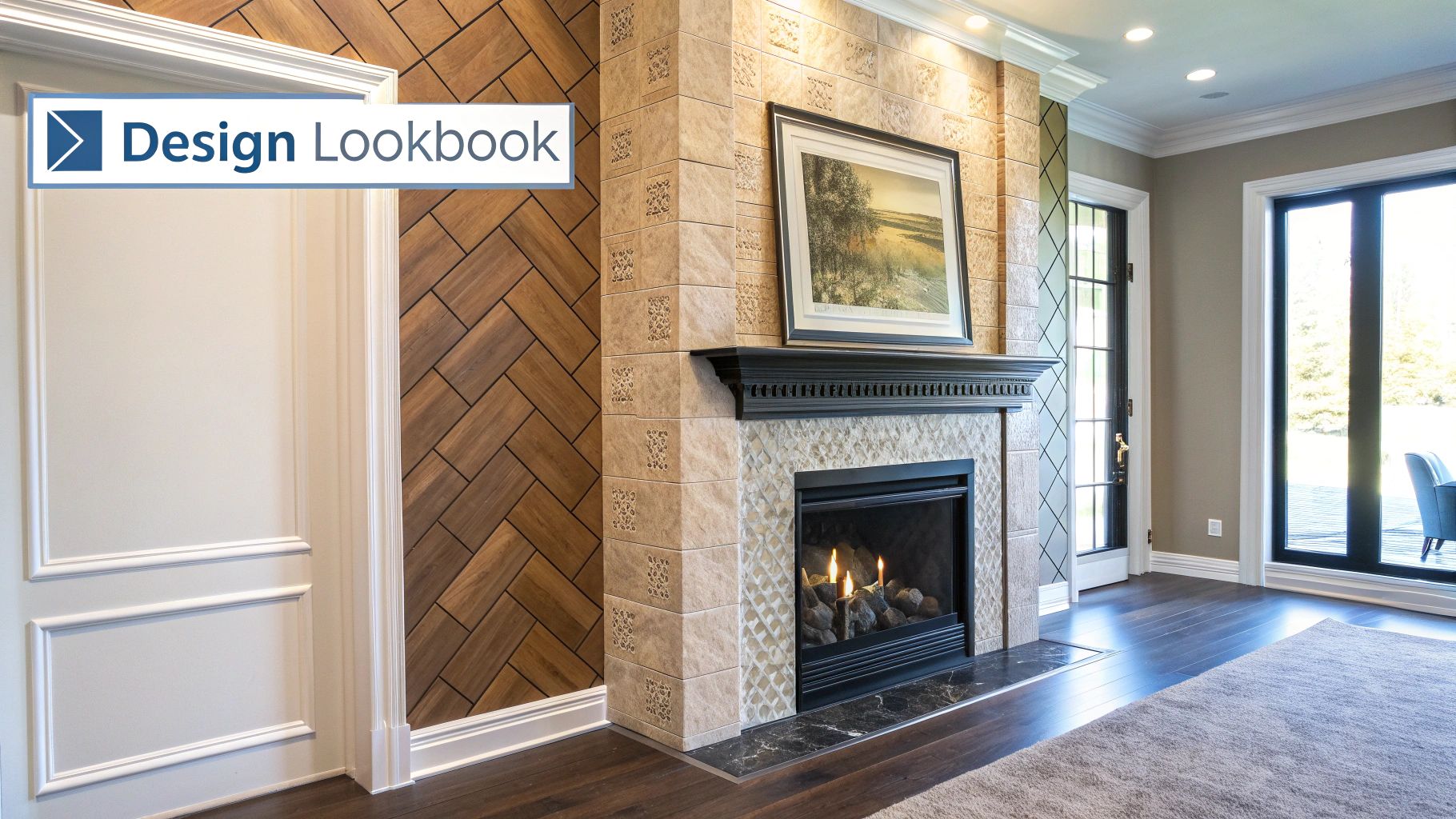
Unlocking New Design and Performance Potential
This focus on a lightweight, flexible profile doesn’t just help the planet; it gives architects and designers a whole new level of creative freedom. Flomary’s stone veneers bring unique properties to the table that simply outperform conventional materials.
One of the most impressive features is their remarkable flexibility. We all know traditional stone is rigid, which largely confines it to flat surfaces. Flomary’s veneers, on the other hand, can be applied to curved walls, columns, and other flowing architectural features. This opens up a world of design possibilities that were once too difficult or costly to achieve with real stone.
The ability to wrap real stone around curved surfaces represents a significant step forward in material science. It allows for more organic and fluid architectural expressions without sacrificing the authenticity of a natural finish.
This flexibility, paired with the material's light weight, also makes installation far simpler. Solid stone slabs are heavy, demanding extensive structural support and specialised labour—driving up project timelines and costs. In contrast, these eco-friendly veneers are easier to handle and much faster to install, often without needing to reinforce the wall behind them.
The Clear Advantages of Flomary’s Approach
Choosing an advanced stone veneer solution like Flomary’s really does bring together the best of all worlds: aesthetics, performance, and sustainability. These benefits lead directly to better project outcomes and a much smaller environmental footprint.
- Authentic Natural Beauty: Each panel keeps the unique texture, colour variations, and timeless character of real quarried stone.
- Unmatched Flexibility: It follows the lines of curved and irregular surfaces, allowing for innovative designs that push past the limits of traditional stone.
- Significant Weight Reduction: Weighing up to 70% less than solid stone, it reduces structural load, simplifies transport, and lowers installation costs.
- Enhanced Sustainability: The manufacturing process minimises waste and cuts transportation emissions, fitting perfectly with modern green building standards.
These features make it an ideal choice for almost any application, from sophisticated interior feature walls to durable and eye-catching exterior facades. Diving into the world of eco-friendly building materials shows just how much sustainable choices are shaping the future of construction. By opting for this forward-thinking veneer wall cladding, you aren’t just choosing a beautiful finish—you’re investing in a smarter, more responsible way to build.
Installing and Maintaining Veneer Cladding
Bringing the beauty of veneer wall cladding into your space is a two-part story: the careful installation and the simple, long-term care that follows. While the nitty-gritty is best left to the pros, understanding the core steps helps you know what to expect, whether you're hiring a team or are a seasoned DIY enthusiast. Just as important is knowing how to look after your new wall, ensuring it stays a stunning feature for decades to come.
It all starts long before the first panel goes up. The success of the entire project really hinges on proper surface preparation. Your wall needs to be structurally sound, perfectly clean, and free from any dust, grease, or old paint that could get in the way of a strong bond.
In some cases, especially on exterior walls or in damp areas like bathrooms, a moisture barrier might be necessary. This is a crucial step to prevent any moisture from getting trapped behind the veneer, which could cause problems down the line.
The Installation Journey
With a clean and primed surface ready to go, the real magic can begin. Installing veneer cladding is a methodical process where precision is everything. It’s what separates a professional, seamless finish from an amateur one. Though the exact techniques might differ slightly depending on the specific product, the general flow is pretty consistent.
- Applying the Right Adhesive: A high-quality, polymer-modified adhesive or mortar is spread evenly across the wall or onto the back of each panel. Using the right adhesive isn't just a suggestion—it's the critical element that ensures a permanent, secure bond.
- Setting the Veneer Panels: Installers typically start from the bottom and work their way up. Each panel is pressed firmly into the adhesive, often with a slight wiggle, to ensure the mortar spreads out and creates a solid, uniform grip.
- Ensuring a Natural Look: This is where the artistry comes in. To avoid obvious, repetitive vertical lines, the joints between panels are staggered. This simple trick beautifully mimics the random, organic pattern of a traditional stone wall and has a huge impact on the final look.
- Finishing and Sealing: Once the panels are set and the adhesive has had time to cure properly, any gaps might be filled with grout. For natural stone, the final touch is usually a coat of high-quality sealant to protect the surface from moisture and stains.
For a closer look at this process, particularly when working with modern, lightweight materials, our guide on thin stone veneer installation offers some great, detailed insights.
Long-Term Care and Maintenance
One of the best things about veneer wall cladding is just how little day-to-day maintenance it needs. A few simple routines are all it takes to keep it looking as good as the day it was installed.
The secret to lasting beauty isn't intensive work; it's gentle, consistent care. The right cleaning methods will protect your investment and preserve the veneer's natural character for years to come.
Your cleaning approach will change a bit based on the material:
- Stone Veneer: For a regular clean-up, a soft-bristled brush and a bit of mild soap and water are all you need. It's really important to avoid harsh, acidic cleaners or high-pressure power washers, as they can easily damage the stone's surface or strip away the sealant.
- Wood Veneer: Best suited for indoors, wood veneer just needs a regular dusting with a soft, dry cloth. If you need to clean a spot, use a slightly damp cloth with a wood-safe cleaner and always wipe in the direction of the grain.
- Addressing Minor Issues: If you get a small scuff or stain on stone veneer, check the manufacturer's care guide. More often than not, a targeted cleaning with a pH-neutral cleaner can fix the issue without harming the surrounding area.
Answering Your Top Questions About Veneer Wall Cladding
Even with all the benefits laid out, it's natural to have a few lingering questions. When people are considering veneer wall cladding for the first time, a few key queries always pop up. Let's tackle them head-on so you can feel confident in your decision.
Can I Use Veneer in Wet Areas Like a Bathroom?
Absolutely, but it demands the right approach. While the stone veneer itself is often water-resistant, the real key to success is in the installation. Think of it as creating a completely waterproof system.
This means starting with a waterproof backer board, using a high-bond adhesive designed for damp conditions, and most importantly, finishing with a quality sealant. This final step creates an invisible shield against moisture. For a high-splash zone like a shower wall, always double-check the manufacturer's specific recommendations to be sure the product is rated for that kind of direct exposure.
How Does Veneer Cladding Hold Up Against Solid Walls?
It's tougher than you might think. Natural stone veneer gives you the same hard-wearing surface you'd get from solid stone—it stands up beautifully to scratches, bumps, and sun-fading. Since it’s installed over a structural wall, it gets all the strength of that underlying support.
Newer materials, like our thermo-treated bamboo or flexible stone veneers, are engineered from the ground up to resist weathering, rot, and UV damage. In many cases, they’ll actually outperform traditional finishes over the long run.
There's a common myth that "veneer" is just a flimsy covering. The reality couldn't be more different. A quality veneer is a robust, high-performance skin for your building, designed to protect and endure for years.
Is This a Project I Can DIY?
That really comes down to the specific product and your own comfort level. Some of the lighter, panel-style systems can be a great project for a skilled DIYer who has a good eye for detail and is patient with prep work.
However, getting that flawless, professional finish—especially with natural stone patterns or around tricky corners—takes real precision. If you want results that are not only beautiful but built to last, we almost always suggest bringing in a professional installer. They have the experience to get it right the first time.
How Does the Cost Stack Up Against Other Wall Finishes?
Veneer wall cladding occupies a smart middle ground. It's more of an investment upfront than a simple coat of paint, but its incredible durability and minimal upkeep deliver far greater value over its lifetime.
On the other end of the spectrum, it's significantly more affordable than full-bed solid stone masonry. You save on the material itself, on transport, and on labour, making that premium, high-end look much more attainable.
Ready to transform your space with a material that balances authentic beauty, performance, and sustainability? Explore the innovative solutions offered by Flomary and see how our advanced stone veneers can bring your vision to life. Discover our full range.

